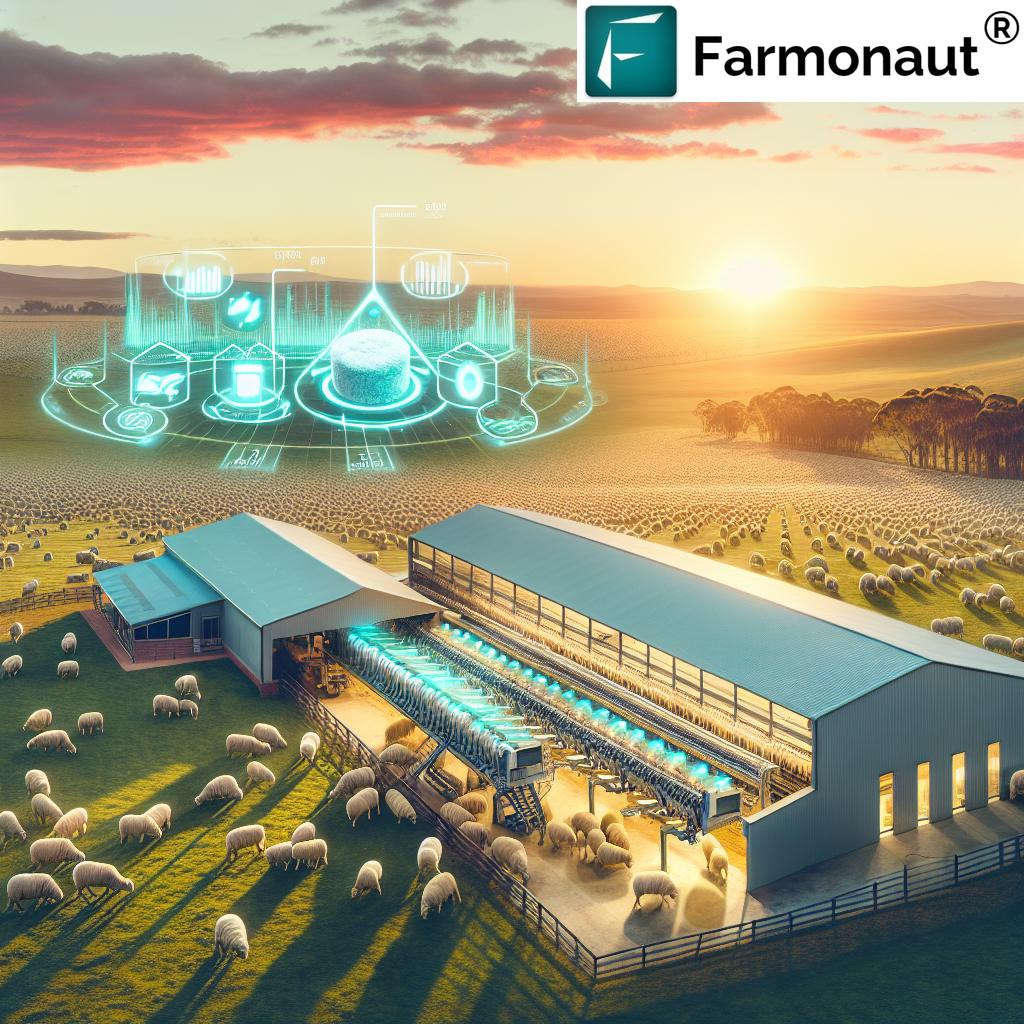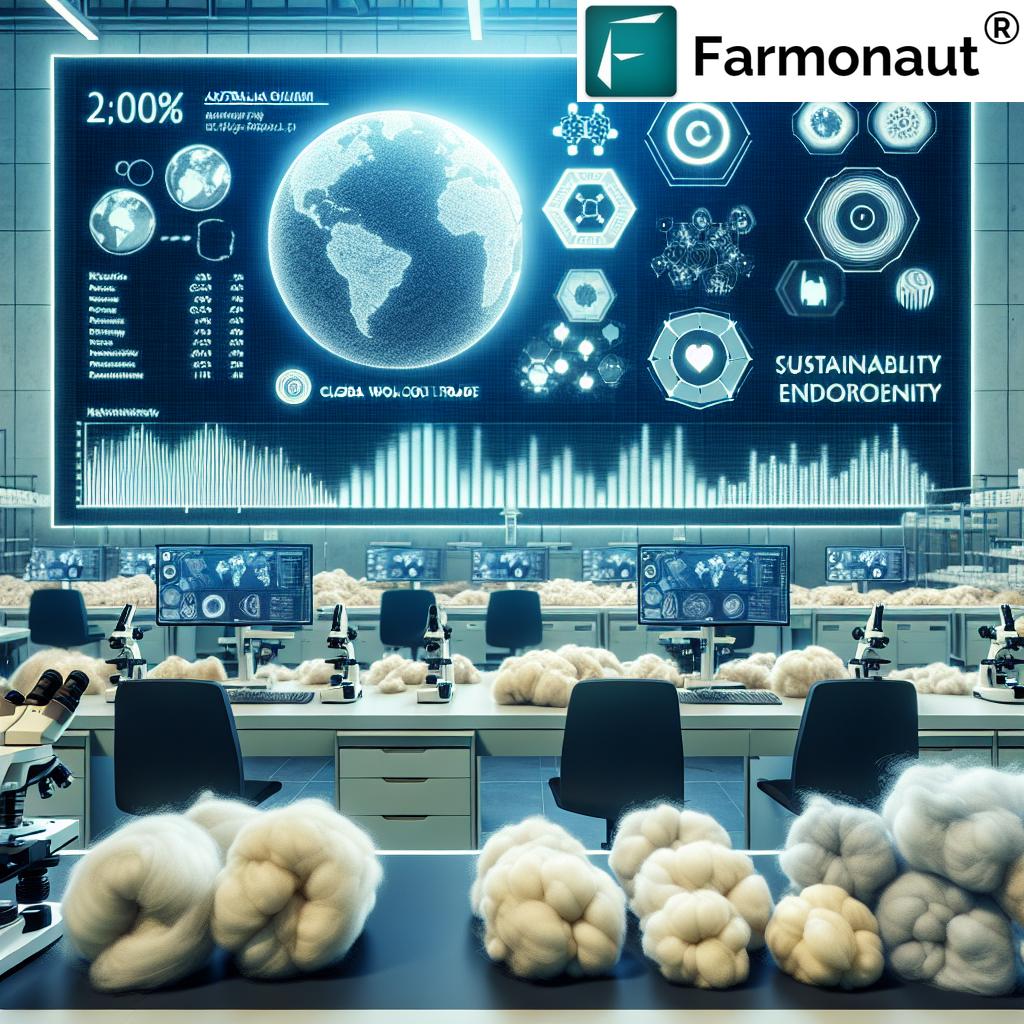Australian Wool Industry: Pioneering Sustainable Production and Quality Assurance in Global Markets
“Australia exports over 90% of its wool production, making it the world’s largest wool exporter.”
In the ever-evolving landscape of global agriculture, the Australian wool industry stands as a beacon of innovation, sustainability, and quality. As we delve into the intricate world of wool production, we’ll explore how this vital sector is adapting to meet the challenges of the 21st century while maintaining its position as a leader in the global market.
The Current State of the Australian Wool Industry
The Australian wool industry has long been a cornerstone of the nation’s agricultural sector, contributing significantly to the economy and rural communities. Today, we’re witnessing a transformation as the industry embraces sustainable wool production and innovative farming practices to maintain its global competitiveness.
- Annual production: Approximately 300 million kg of wool
- Export value: Over AUD 3 billion annually
- Global market share: Around 25% of the world’s wool
These figures underscore the importance of the Australian wool industry on the global stage. However, to maintain this position, the industry is continuously evolving, focusing on quality assurance, sustainability, and technological innovation.

Sustainable Wool Production: A New Era
Sustainability has become a watchword in the Australian wool industry, with producers recognizing the need to balance productivity with environmental stewardship. This shift towards sustainable wool production is not just an ethical choice but a business imperative in a market increasingly driven by eco-conscious consumers.
Key Sustainability Initiatives
- Regenerative farming practices: Many woolgrowers are adopting techniques that improve soil health, increase biodiversity, and enhance carbon sequestration.
- Water conservation: Innovative irrigation systems and drought-resistant pasture management are reducing water usage across the industry.
- Animal welfare: The industry is implementing stringent animal welfare standards, moving away from practices like mulesing in favor of more humane alternatives.
These sustainability schemes are not only shaping the future of wool production but are also becoming a key differentiator in the global marketplace. Consumers and processors alike are increasingly seeking wool that meets high environmental and ethical standards.
Quality Assurance in the Australian Wool Industry
Quality assurance remains paramount in maintaining Australia’s reputation as a producer of premium wool. The industry has developed robust systems to ensure that every bale of Australian wool meets the highest standards.
Clip Preparation Techniques
The process of clip preparation is crucial in maintaining wool quality. Australian woolgrowers employ meticulous techniques to ensure their wool meets market demands:
- Shearing: Skilled shearers remove the fleece in one piece, minimizing second cuts.
- Skirting: Removal of lower quality wool from the edges of the fleece.
- Classing: Wool is sorted based on various characteristics such as fiber diameter, staple length, and strength.
- Baling: Classified wool is pressed into bales, ready for testing and sale.
These clip preparation techniques are essential in maintaining the high standards that international buyers expect from Australian wool.
Wool Processing Technology: Advancing with Innovation
The wool industry is not just about production; processing plays a crucial role in delivering high-quality products to the market. Australian wool processors are at the forefront of technological innovation, employing cutting-edge techniques to enhance efficiency and quality.
Advanced Processing Techniques
- Automated sorting systems: Using artificial intelligence and machine vision to classify wool more accurately and efficiently.
- Eco-friendly scouring: Implementing water recycling and biodegradable detergents to reduce environmental impact.
- Precision dyeing: Utilizing computer-controlled dyeing processes for consistency and reduced chemical usage.
These advancements in wool processing technology not only improve the quality of the final product but also align with the industry’s sustainability goals.
Global Wool Market Trends: Navigating Challenges and Opportunities
The global wool market is dynamic, influenced by various factors ranging from fashion trends to economic conditions. Understanding these trends is crucial for Australian woolgrowers to remain competitive.
Current Market Dynamics
- Increasing demand for sustainable fibers: Consumers are showing a preference for natural, eco-friendly materials, benefiting wool producers.
- Volatility in Chinese demand: As the largest importer of Australian wool, fluctuations in Chinese demand significantly impact the market.
- Competition from synthetic fibers: Ongoing innovation in synthetic materials poses a challenge to wool’s market share.
To address these trends, the Australian wool industry is focusing on diversifying markets, enhancing traceability, and promoting wool’s natural and sustainable qualities.

International Trade Standards and Export Regulations
Navigating the complex landscape of international trade is crucial for the Australian wool industry. Compliance with various standards and regulations is essential to maintain market access and consumer confidence.
Key Standards and Regulations
- IWTO standards: The International Wool Textile Organisation sets global standards for wool testing and certification.
- Phytosanitary requirements: Ensuring wool meets the health and safety standards of importing countries.
- Ethical trading certifications: Such as the Responsible Wool Standard (RWS) which is gaining importance in international markets.
Australian woolgrowers and exporters must stay informed about these evolving standards to ensure compliance and maintain their competitive edge in the global market.
“The Australian wool industry contributes approximately $3 billion annually to the country’s economy.”
Innovative Farming Practices in Australian Wool Production
Innovation is at the heart of the Australian wool industry’s approach to maintaining its global leadership position. Woolgrowers across the country are adopting cutting-edge practices to enhance productivity, sustainability, and animal welfare.
Precision Agriculture in Wool Farming
Precision agriculture techniques are revolutionizing wool production in Australia. These include:
- Satellite-based pasture management: Using remote sensing technology to optimize grazing patterns and pasture health.
- Genetic selection: Employing data-driven breeding programs to improve wool quality and sheep resilience.
- Automated sheep handling systems: Reducing stress on animals and improving efficiency in shearing and health management.
These innovative farming practices are not only improving productivity but also contributing to the industry’s sustainability goals.
The Role of Technology in Modern Wool Production
Technology is playing an increasingly vital role in the Australian wool industry, from farm management to market access. Advanced tools and platforms are empowering woolgrowers to make data-driven decisions and optimize their operations.
Farmonaut: Empowering Woolgrowers with Advanced Technology
In this context, Farmonaut emerges as a valuable ally for Australian woolgrowers. As a pioneering agricultural technology company, Farmonaut offers advanced, satellite-based farm management solutions that align perfectly with the wool industry’s push for sustainability and efficiency.
Key features of Farmonaut’s platform that benefit woolgrowers include:
- Real-time crop health monitoring: While primarily focused on crops, this technology can be adapted to monitor pasture health, crucial for sheep grazing.
- AI-based advisory systems: Providing personalized insights for optimal farm management.
- Blockchain-based traceability: Enhancing transparency in the wool supply chain, a growing demand in international markets.
By leveraging these technologies, Australian woolgrowers can optimize their operations, reduce resource wastage, and meet the growing demand for sustainable and traceable wool production.
Quality Control Measures in the Wool Industry
Maintaining the highest standards of quality is paramount in the Australian wool industry. A robust system of quality control measures ensures that Australian wool continues to meet and exceed international expectations.
Key Quality Control Processes
- On-farm quality management: Implementing best practices in sheep health, nutrition, and fleece management.
- Wool classing: Professional wool classers sort and grade wool based on various quality parameters.
- Testing and certification: Independent laboratories conduct rigorous testing on wool samples for characteristics like fiber diameter, strength, and yield.
- Auction system quality checks: Additional inspections and testing at wool auctions ensure compliance with buyer specifications.
These quality control measures are crucial in maintaining Australia’s reputation as a producer of premium wool and ensuring fair prices for growers.
Challenges and Opportunities in the Australian Wool Sector
While the Australian wool industry is thriving, it faces several challenges that also present opportunities for innovation and growth.
Current Challenges
- Climate variability: Droughts and extreme weather events impact wool production and quality.
- Labor shortages: Finding skilled workers, especially shearers, is an ongoing issue.
- Market volatility: Fluctuations in global demand and prices can affect industry stability.
Emerging Opportunities
- Sustainable fashion: Growing consumer preference for eco-friendly fibers positions wool favorably.
- Technological integration: Adopting advanced technologies like those offered by Farmonaut can enhance productivity and sustainability.
- New market development: Exploring emerging markets to diversify export destinations.
By addressing these challenges and capitalizing on opportunities, the Australian wool industry can continue to thrive in the global marketplace.
The Future of Australian Wool: Forecasts and Projections
Looking ahead, the Australian wool industry is poised for continued growth and innovation. Industry experts and analysts provide insights into what the future might hold for this vital sector.
Key Projections
- Production growth: Modest increases in wool production are expected as flocks recover from drought impacts.
- Price trends: Analysts predict stable to rising prices for premium quality wool, driven by demand for sustainable fibers.
- Sustainability adoption: A significant increase in the number of farms adopting certified sustainable practices is anticipated.
- Technological integration: Widespread adoption of precision agriculture tools, including satellite-based solutions like Farmonaut, is expected to boost efficiency.
These projections paint a picture of an industry that is adapting to change and leveraging innovation to secure its future.
Explore Farmonaut’s API for advanced agricultural data
Sustainability Schemes Shaping the Future of Wool Production
Sustainability is no longer just a buzzword in the wool industry; it’s becoming a fundamental aspect of production and marketing. Various sustainability schemes are influencing how wool is produced and perceived in the global market.
Leading Sustainability Initiatives
- Responsible Wool Standard (RWS): A global standard that addresses the welfare of sheep and the land they graze on.
- Sustainable Cape Wool Standard: Focused on promoting sustainable practices in wool production in South Africa, influencing global standards.
- ZQ Merino: A certification program ensuring ethical wool production, animal welfare, and environmental care.
- Nativa Precious Fiber: A sustainability and traceability certification for wool and other natural fibers.
These schemes are not only improving the industry’s environmental footprint but are also becoming crucial for market access and premium pricing.
The Impact of Technology on Wool Quality Assurance
Technology is revolutionizing how wool quality is assessed and assured throughout the supply chain. From the farm to the final product, innovative tools are enhancing accuracy, efficiency, and transparency in quality control processes.
Technological Advancements in Quality Assurance
- Laser scanning for fiber measurement: Providing more accurate and detailed analysis of wool characteristics.
- Blockchain for traceability: Ensuring the authenticity and origin of wool from farm to consumer.
- AI-powered defect detection: Identifying and classifying wool defects with greater precision than traditional methods.
- Near-infrared spectroscopy (NIRS): Rapid, non-destructive testing of wool properties.
These technologies are not only improving the consistency and reliability of wool quality but also building trust with consumers and processors.
Check out Farmonaut’s API Developer Docs for integration possibilities
Australian Wool in the Global Fashion Industry
Australian wool continues to play a significant role in the global fashion industry, prized for its quality, versatility, and increasingly, its sustainability credentials.
Trends in Wool Fashion
- Athleisure wear: The rise of performance wool in activewear and casual clothing.
- Sustainable luxury: High-end fashion brands increasingly sourcing traceable, sustainable Australian wool.
- Innovative blends: Combining wool with other natural or technical fibers for enhanced performance.
- Circular fashion: Growing interest in wool’s biodegradability and recyclability in the context of sustainable fashion.
These trends highlight the ongoing relevance and adaptability of Australian wool in meeting evolving consumer preferences and industry demands.
Education and Training in the Wool Industry
Ensuring a skilled workforce is crucial for the future of the Australian wool industry. Various educational and training initiatives are in place to develop the next generation of wool industry professionals.
Key Educational Programs
- Vocational training: Courses in wool classing, shearing, and farm management.
- University degrees: Agricultural science programs with specializations in wool production and textile technology.
- Industry workshops: Regular training sessions on new technologies and best practices.
- International exchange programs: Opportunities for knowledge sharing with global wool industry partners.
These educational initiatives are vital in maintaining Australia’s leadership in wool production and innovation.
The Role of Research and Development in Advancing the Wool Industry
Ongoing research and development (R&D) are crucial drivers of innovation and improvement in the Australian wool industry. Significant investments are made in various areas to enhance productivity, sustainability, and product quality.
Key R&D Focus Areas
- Genetic improvement: Developing sheep breeds with superior wool qualities and disease resistance.
- Sustainable farming practices: Researching methods to reduce environmental impact while maintaining productivity.
- New wool applications: Exploring innovative uses for wool in technical textiles and other industries.
- Processing technologies: Developing more efficient and eco-friendly wool processing methods.
These R&D efforts are essential in keeping the Australian wool industry at the forefront of global wool production and innovation.
Australian Wool Industry Key Performance Indicators
| Indicator | Current Value | 5-Year Projection |
|---|---|---|
| Annual Wool Production (tonnes) | 300,000 | 320,000 |
| Export Value (AUD) | 3 billion | 3.5 billion |
| Sustainability Certification Adoption (%) | 40% | 70% |
| Average Fiber Diameter (microns) | 21 | 20.5 |
| Global Market Share (%) | 25% | 27% |
| Technology Adoption Rate (%) | 60% | 85% |
Conclusion: The Future of Australian Wool
As we look to the future, the Australian wool industry stands at an exciting crossroads. With its commitment to sustainability, quality assurance, and technological innovation, the industry is well-positioned to meet the challenges and opportunities of the global market.
The integration of advanced technologies, such as those offered by Farmonaut, will play a crucial role in enhancing productivity and sustainability. As the industry continues to evolve, it will be those producers and processors who embrace innovation and sustainability that will lead the way in shaping the future of Australian wool.
By maintaining its focus on quality, sustainability, and innovation, the Australian wool industry is set to continue its legacy as a global leader in wool production, contributing significantly to the nation’s economy and rural communities for generations to come.
FAQ Section
Q1: What makes Australian wool unique in the global market?
A1: Australian wool is renowned for its high quality, fine fibers, and versatility. The country’s diverse climate allows for the production of a wide range of wool types, suitable for various applications from fine suiting to durable outdoor wear.
Q2: How is the Australian wool industry addressing sustainability concerns?
A2: The industry is implementing various sustainability initiatives, including regenerative farming practices, water conservation measures, and animal welfare improvements. Many producers are also adopting sustainability certifications to meet growing consumer demand for eco-friendly products.
Q3: What role does technology play in modern Australian wool production?
A3: Technology is increasingly important in wool production, from precision agriculture techniques for pasture management to advanced processing technologies. Tools like Farmonaut’s satellite-based monitoring systems are helping woolgrowers optimize their operations and improve sustainability.
Q4: How does the wool auction system work in Australia?
A4: The Australian wool auction system is a open-cry auction where buyers bid on catalogued lots of wool. These auctions are held regularly in major wool-producing centers across the country, with prices influenced by factors such as quality, global demand, and currency exchange rates.
Q5: What are the main challenges facing the Australian wool industry today?
A5: Key challenges include climate variability affecting production, labor shortages (particularly in shearing), market volatility, and competition from synthetic fibers. The industry is addressing these through innovation, education, and diversification strategies.




















